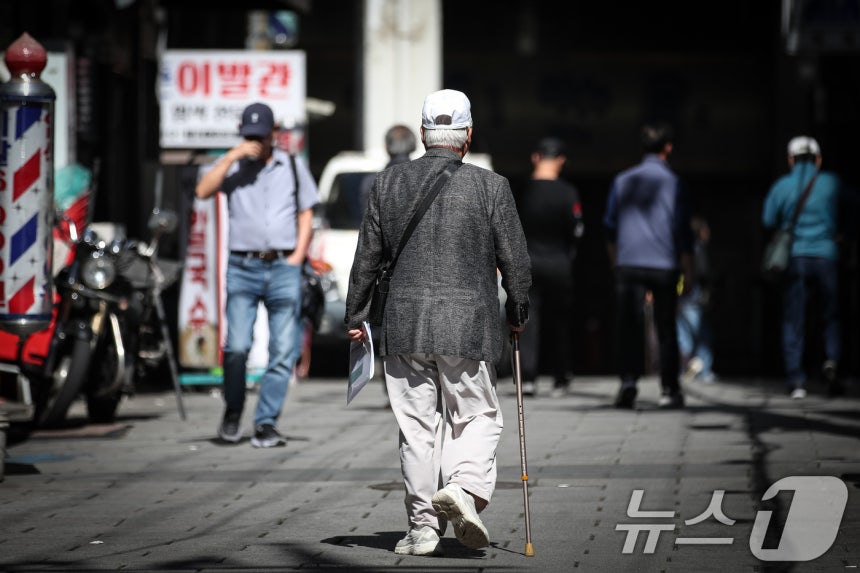Single-person households with the response ‘healthy’ are 14.4% lower than elderly couple households
Elderly with three or more chronic diseases increased by 5.1%p compared to 2020,

ⓒ News1 Reporter Lee Seung-bae ,
,
, ‘(Sejong=news1) Kim Yoo-seung Reporter = It was found that the proportion of elderly living alone among all elderly households last year increased by 13.0 percentage points (p) compared to 2020.’,
,
, ‘The average number of chronic diseases that the elderly had was 2.2, an increase from 1.9 in 2020.’,
,
, “According to the ‘2023 Elderly Survey Results’ released by the Ministry of Health and Welfare on the 16th, the forms of elderly households last year were ranked in the order of couple households (55.2%), single-person households (32.8%), and households living with children (10.3%).”,
,
, ‘In particular, the ratio of single-person households (elderly living alone) increased by 13.0 percentage points compared to the 2020 survey. As a result, the average number of household members decreased from 2.0 to 1.8.’,
,
, ‘Dr. Kang Eun-na of the Korea Institute for Health and Social Affairs explained, “One of the reasons for the increasing proportion of elderly living alone is the cumulative changes in household forms,” and added, “Analysis shows that the proportion of entering old age in a single-person household form is increasing among those aged 65-69.”‘,
,
, ‘She further added, “The rate of living alone without problems has also increased as the rate of death after 85 years old has increased, and healthy individuals with no issues living alone without their children have also increased.”‘,
,
, ‘Single-person households face various disadvantages compared to other household forms.’,
,
, ‘The percentage of those who responded as being healthy was 34.2%, lower than the 48.6% for elderly couple households, and they were assessed to be in a more disadvantaged situation than other household forms in various aspects such as depressive symptoms, nutrition management, and difficulties in daily life.’,
,
,

Key features by household type (Provided by Welfare Department) ,
,
, ‘The percentage of the total elderly who are in contact with their children decreased from 67.8% in 2020 to 64.9%. It was found that 9.2% of the elderly do not have children they can contact.’,
,
, ‘The proportion of elderly with depressive symptoms was 11.3%, a decrease by 2.2 percentage points from 13.5% in 2020.’,
,
, ‘The percentage of elderly who experienced a falling accident in the past year decreased by 1.6 percentage points to 5.6%, and the proportion of those who used outpatient clinic services for medical treatment in the past month as of 2023 was 68.8%, a decrease by 1.8 percentage points.’,
,
, ‘However, the overall health status of the elderly worsened compared to 2020.’,
,
, ‘The elderly had an average of 2.2 chronic diseases, which was an increase from 1.9 in 2020.’,
,
, ‘The percentage of elderly with three or more chronic diseases increased to 35.9%, a rise of 5.1%p, while those with no chronic diseases decreased from 16.0% to 13.9%.’,
,
, ‘It was noted that 18.6% of the elderly showed functional limitations when evaluating their daily living activities, instrumental activities of daily living, and physical functional status. This was a significant increase from 12.2% in 2020.’,
,
, ‘Among the elderly who responded as having physical functional limitations at 18.6%, 47.2% were found to be receiving care.’,
,
, “In response to questions about caregivers, the proportion who responded ‘long-term care insurance services’ significantly increased to 30.7% from 19.1% in 2020. Others included family at 81.4%, relatives/neighbors at 20.0%, and individual caregivers at 11.0%.”,
,
, ‘Im Eul-ki, a senior policy officer at the Ministry of Health and Welfare, explained, “With the extension of average lifespan, an aging trend is emerging, leading to the assumption that chronic diseases and functional limitations are increasing concurrently.”‘,
,
, ‘Responses to whether current care services are sufficient showed that 49.4% said they were sufficient, 32.2% said they were average, and 18.3% said they were insufficient. As for areas requiring improvement in care services, respondents prioritized functional recovery training/rehabilitation services at 37.0%, followed by diversification of services at 25.7%, and expansion of service hours at 24.0%.’,
,
, ‘Among the elderly who responded that they have no one to turn to in situations such as when they are sick and need help at home, when they feel discouraged or depressed, or when they suddenly need a large amount of money, the proportion was 6.6%, with the ratio increasing with age.’

